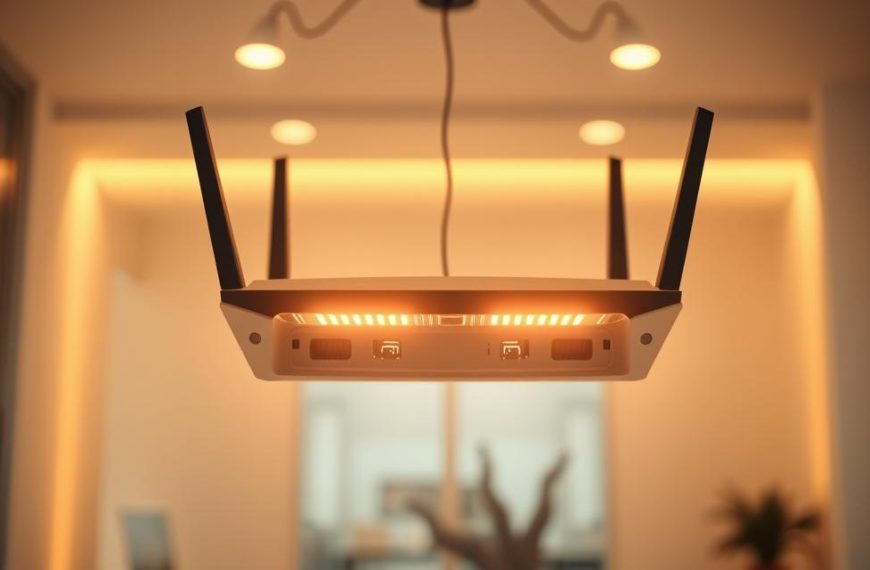The fifth-generation cellular network is reshaping the landscape of connected devices. With speeds 10 times faster than 4G and latency under 1 millisecond, it offers unmatched performance. This advancement is crucial for the growth of IoT ecosystems, enabling seamless communication between devices.
Market trends highlight a 7% year-over-year increase in cellular IoT adoption during Q1 2024. This growth is driven by the network’s ability to support up to 1 million devices per square kilometer. Such capacity ensures scalability for industries relying on IoT solutions.
Technical specifications like 3GPP Release 17 and NR-Light further optimize connectivity for IoT devices. These developments enhance energy efficiency and reliability, making real-time applications more accessible. For more insights, explore this detailed analysis.
Introduction to 5G and IoT
Advanced wireless networks are revolutionizing connectivity for smart devices. These networks provide faster speeds, lower latency, and greater reliability, making them ideal for IoT ecosystems. Understanding the technical foundations of these advancements is key to unlocking their full potential.
What is 5G Technology?
5G is built on millimeter waves, which operate at frequencies above 24GHz. This allows for speeds ranging from 1 to 10Gbps, far surpassing 4G’s 1Gbps cap. Network slicing and 3GPP standards further optimize performance, ensuring efficient data transmission across various applications.
What is the Internet of Things (IoT)?
IoT refers to a network of interconnected devices that collect and exchange data. These devices rely on sensors, data protocols like AMQP and DDS, and LPWAN networks for seamless communication. IoT technologies are transforming industries by enabling real-time monitoring and automation.
The Synergy Between 5G and IoT
5G’s 1ms latency is a game-changer for IoT applications, particularly in industrial automation. Ericsson’s RedCap devices have reduced modem complexity by 65%, making them more efficient for massive IoT deployments. Compared to 4G’s LTE-M and NB-IoT limitations, 5G supports a higher density of devices, ensuring scalability.
| Feature | 4G | 5G |
|---|---|---|
| Speed | Up to 1Gbps | 1-10Gbps |
| Latency | 30-50ms | Under 1ms |
| Device Density | Limited | 1 million per sq. km |
How Does 5G Technology Enhance the Internet of Things?
Modern networks are unlocking new possibilities for interconnected devices. These advancements bring faster speeds, lower latency, and improved reliability, making them essential for IoT ecosystems. Let’s explore the key benefits in detail.
Faster Data Transfer Speeds
With speeds reaching up to 10Gbps, data transfer is 10 times faster than previous generations. This enables high-bandwidth applications like 4K video analytics in smart cities. Faster speeds ensure seamless communication between devices, improving overall efficiency.
Lower Latency for Real-Time Applications
Latency is reduced to under 1 millisecond, making it ideal for real-time applications. Autonomous vehicles and remote surgery rely on this low latency for instant responses. Such precision is critical for industries where timing is everything.
Improved Energy Efficiency
Energy consumption is significantly reduced, with some devices using 65% less power. This extends battery life for IoT devices like agricultural sensors. Optimized small packet handling ensures devices operate efficiently, even in remote locations.
Greater Network Reliability
Network reliability is enhanced with 99.999% uptime, ensuring continuous operation for critical infrastructure. This level of dependability is crucial for applications like healthcare wearables and industrial automation. Reliable connectivity supports scalable IoT deployments.
5G’s Role in IoT Applications
The integration of advanced networks is transforming IoT applications across industries. From urban planning to healthcare, these innovations are reshaping how devices interact and operate. Let’s explore the key areas where this synergy is making a significant impact.
Smart Cities and Infrastructure
Urban centers are leveraging IoT to optimize services and improve quality of life. Smart traffic systems use connected sensors to manage signals in real time, reducing congestion and emissions. Air quality monitoring devices, powered by XMPP protocols, provide city-wide coverage for better environmental management.
These technologies ensure efficient resource allocation and sustainable growth. With 1 million devices supported per square kilometer, scalability is no longer a concern. This capability is essential for building smarter, more responsive cities.
Healthcare and Wearable Devices
Healthcare is witnessing groundbreaking advancements with IoT solutions. Implantable glucose monitors, for instance, use ultra-reliable low-latency communication (URLLC) to send emergency alerts instantly. Wearable devices track vital signs, enabling proactive care and reducing hospital visits.
These innovations improve patient outcomes and streamline medical services. The reliability of modern networks ensures continuous monitoring, even in critical situations. This is a game-changer for both patients and healthcare providers.
Industrial IoT (IIoT) and Automation
Manufacturing and industrial sectors are adopting IoT for enhanced efficiency. Predictive maintenance systems, integrated with OPC UA standards, minimize downtime and reduce costs. Ericsson’s large-scale factory automation solutions demonstrate the potential of these technologies.
Such advancements boost productivity and ensure smoother operations. However, challenges like base station density requirements must be addressed for optimal urban coverage. Despite these hurdles, the benefits far outweigh the limitations.
“The future of IoT lies in its ability to adapt and scale with evolving network capabilities.”
In conclusion, IoT applications are driving innovation across multiple sectors. From smart cities to healthcare and industrial automation, the possibilities are endless. As networks continue to evolve, so will the capabilities of connected devices.
Challenges and Solutions in 5G and IoT Integration
The rapid adoption of connected devices brings both opportunities and challenges. As networks expand to support millions of devices, addressing key issues becomes critical for seamless integration. This section explores the primary hurdles and actionable solutions.
Security Concerns and Mitigation Strategies
With up to 1 million devices per square kilometer, the attack surface for malicious activities grows significantly. Legacy IoT devices often lack robust authentication mechanisms, making them vulnerable. Implementing PKI-based authentication, as demonstrated by Nexus Smart ID, can bridge these gaps effectively.
End-to-end encryption and regular firmware updates are also essential. These measures ensure data integrity and protect against breaches. For more insights, explore this detailed analysis.
Energy Consumption and Sustainability
High energy usage remains a concern, especially in remote areas. Solar-powered base stations and LTE-M sleep modes offer sustainable alternatives. These solutions reduce operational costs and extend battery life for IoT devices.
Optimizing small packet handling further minimizes energy consumption. This approach ensures devices operate efficiently, even in challenging environments. Such strategies are vital for long-term sustainability.
Device Compatibility and Network Coverage
Migrating from CAT-M and NB-IoT to 5G NR-Light presents compatibility challenges. However, 3GPP Release 17’s RedCap standard simplifies this transition. It reduces modem complexity by 65%, making it cost-effective for large-scale deployments.
Hybrid 4G/5G networks provide a workaround for areas with limited coverage. This approach ensures uninterrupted connectivity, particularly for agricultural IoT applications. Addressing these hurdles is key to achieving global scalability.
Conclusion
The future of connected devices is being shaped by groundbreaking advancements. With speeds up to 10Gbps, AR/VR interfaces are becoming a reality, transforming how we interact with IoT systems. These technologies are driving efficiency and innovation across industries.
However, challenges like 4G/5G coexistence remain, with transitions expected to continue until 2030. Strategic partnerships, such as those with security providers like Nexus, ensure robust PKI solutions for safe deployments.
Looking ahead, trends like edge computing will fuel growth in autonomous drones and other IoT applications. Businesses must adopt these technologies to stay competitive in a rapidly evolving world.
For businesses ready to scale, platforms like NETSCOUT’s Visibility Without Borders offer the tools needed to maximize the benefits of IoT. Embrace these solutions to unlock the full potential of connected services.












